2017 KIA RIO towing
[x] Cancel search: towingPage 334 of 449
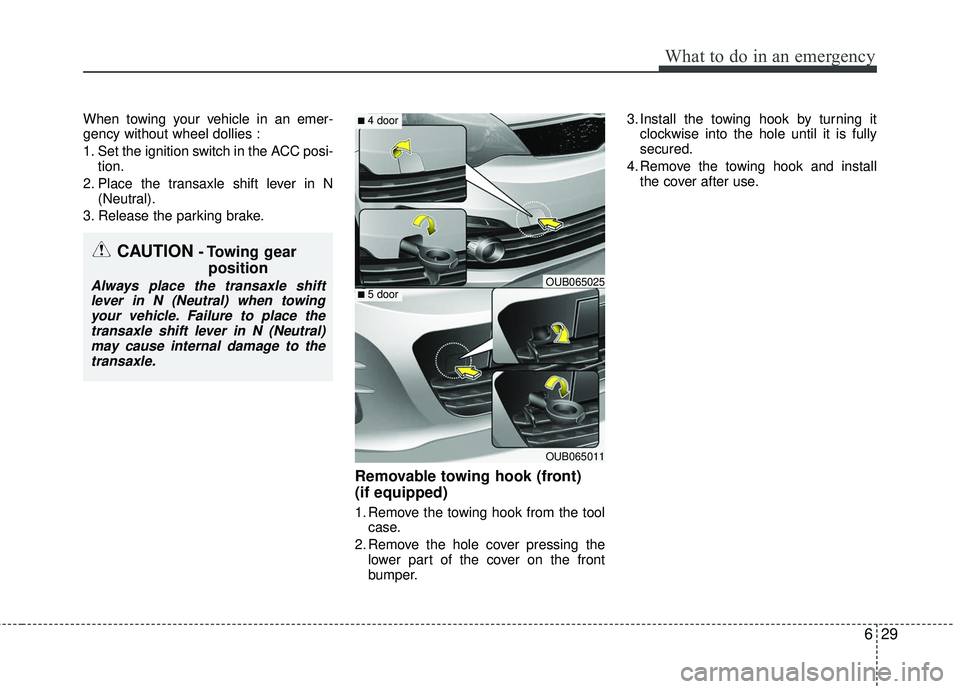
629
What to do in an emergency
When towing your vehicle in an emer-
gency without wheel dollies :
1. Set the ignition switch in the ACC posi-tion.
2. Place the transaxle shift lever in N (Neutral).
3. Release the parking brake.
Removable towing hook (front)
(if equipped)
1. Remove the towing hook from the tool case.
2. Remove the hole cover pressing the lower part of the cover on the front
bumper. 3. Install the towing hook by turning it
clockwise into the hole until it is fully
secured.
4. Remove the towing hook and install the cover after use.
CAUTION - Towing gear position
Always place the transaxle shift
lever in N (Neutral) when towingyour vehicle. Failure to place thetransaxle shift lever in N (Neutral)may cause internal damage to the transaxle.
OUB065011
■ 4 door
■ 5 doorOUB065025
Page 335 of 449
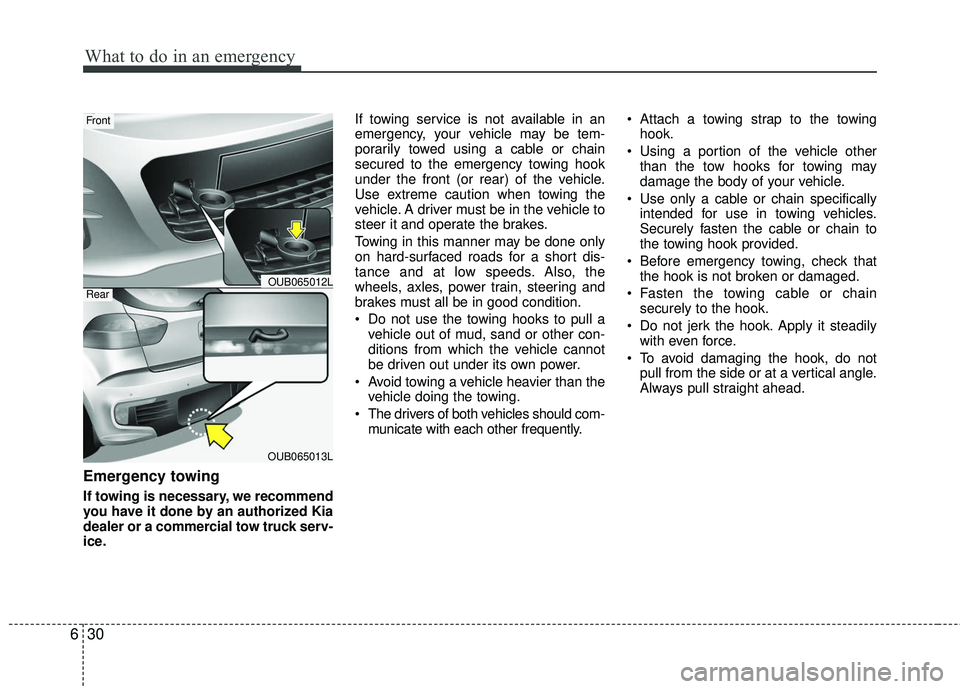
What to do in an emergency
30
6
Emergency towing
If towing is necessary, we recommend
you have it done by an authorized Kia
dealer or a commercial tow truck serv-
ice. If towing service is not available in an
emergency, your vehicle may be tem-
porarily towed using a cable or chain
secured to the emergency towing hook
under the front (or rear) of the vehicle.
Use extreme caution when towing the
vehicle. A driver must be in the vehicle to
steer it and operate the brakes.
Towing in this manner may be done only
on hard-surfaced roads for a short dis-
tance and at low speeds. Also, the
wheels, axles, power train, steering and
brakes must all be in good condition.
Do not use the towing hooks to pull a
vehicle out of mud, sand or other con-
ditions from which the vehicle cannot
be driven out under its own power.
Avoid towing a vehicle heavier than the vehicle doing the towing.
The drivers of both vehicles should com- municate with each other frequently. Attach a towing strap to the towing
hook.
Using a portion of the vehicle other than the tow hooks for towing may
damage the body of your vehicle.
Use only a cable or chain specifically intended for use in towing vehicles.
Securely fasten the cable or chain to
the towing hook provided.
Before emergency towing, check that the hook is not broken or damaged.
Fasten the towing cable or chain securely to the hook.
Do not jerk the hook. Apply it steadily with even force.
To avoid damaging the hook, do not pull from the side or at a vertical angle.
Always pull straight ahead.
OUB065013L
Front
RearOUB065012L
Page 336 of 449
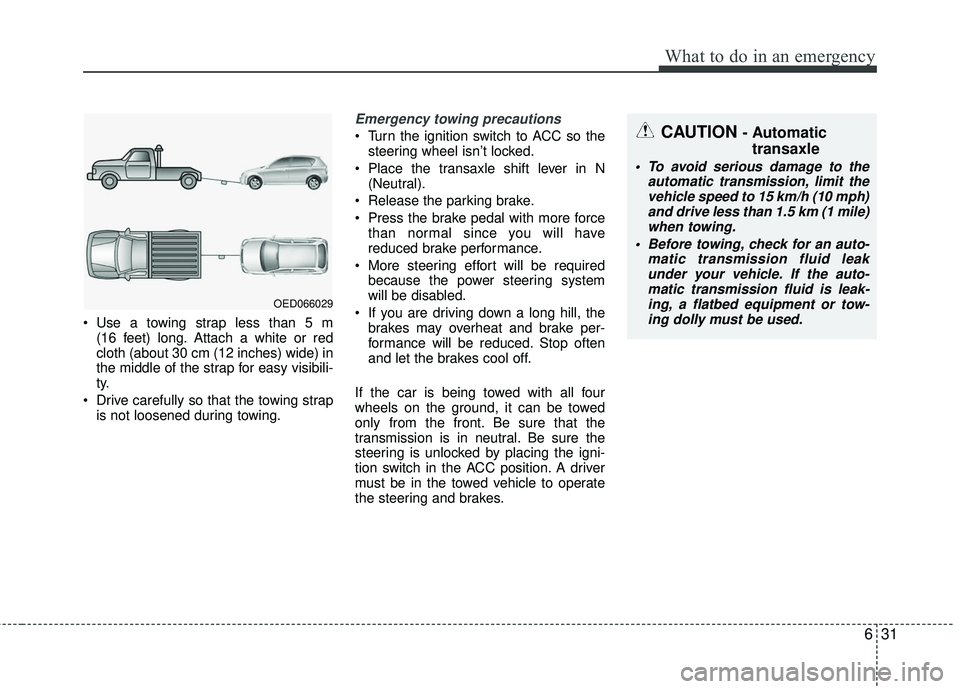
631
What to do in an emergency
Use a towing strap less than 5 m (16 feet) long. Attach a white or red
cloth (about 30 cm (12 inches) wide) in
the middle of the strap for easy visibili-
ty.
Drive carefully so that the towing strap is not loosened during towing.
Emergency towing precautions
Turn the ignition switch to ACC so thesteering wheel isn’t locked.
Place the transaxle shift lever in N (Neutral).
Release the parking brake.
Press the brake pedal with more force than normal since you will have
reduced brake performance.
More steering effort will be required because the power steering system
will be disabled.
If you are driving down a long hill, the brakes may overheat and brake per-
formance will be reduced. Stop often
and let the brakes cool off.
If the car is being towed with all four
wheels on the ground, it can be towed
only from the front. Be sure that the
transmission is in neutral. Be sure the
steering is unlocked by placing the igni-
tion switch in the ACC position. A driver
must be in the towed vehicle to operate
the steering and brakes.CAUTION - Automatic transaxle
To avoid serious damage to the
automatic transmission, limit thevehicle speed to 15 km/h (10 mph)and drive less than 1.5 km (1 mile)when towing.
Before towing, check for an auto- matic transmission fluid leakunder your vehicle. If the auto- matic transmission fluid is leak-ing, a flatbed equipment or tow- ing dolly must be used.
OED066029
Page 343 of 449
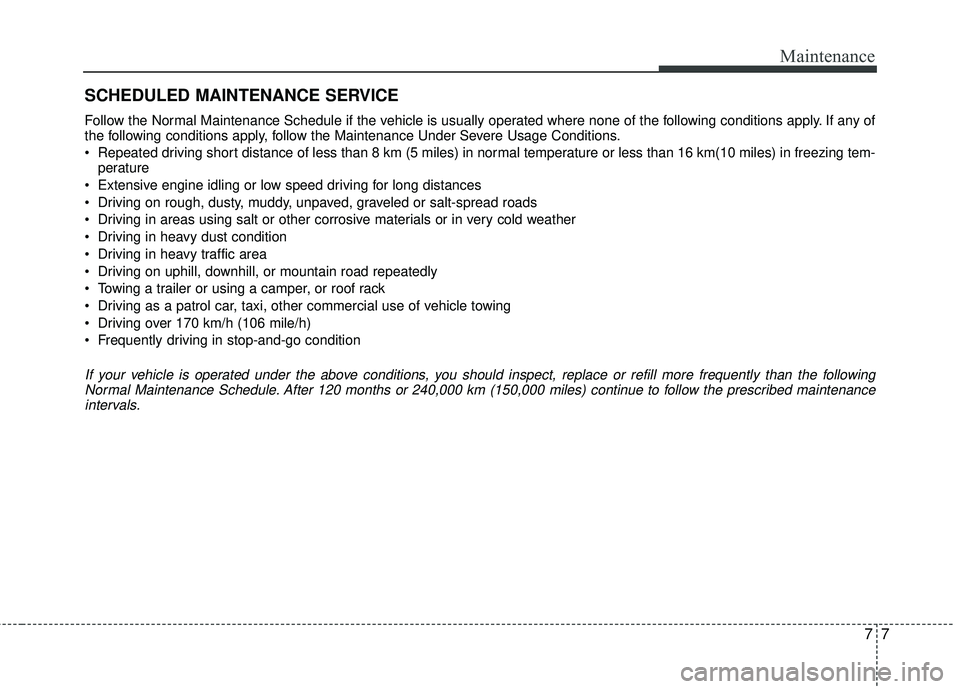
77
Maintenance
SCHEDULED MAINTENANCE SERVICE
Follow the Normal Maintenance Schedule if the vehicle is usually operated where none of the following conditions apply. If any of
the following conditions apply, follow the Maintenance Under Severe Usage Conditions.
Repeated driving short distance of less than 8 km (5 miles) in normal temperature or less than 16 km(10 miles) in freezing tem-perature
Extensive engine idling or low speed driving for long distances
Driving on rough, dusty, muddy, unpaved, graveled or salt-spread roads
Driving in areas using salt or other corrosive materials or in very cold weather
Driving in heavy dust condition
Driving in heavy traffic area
Driving on uphill, downhill, or mountain road repeatedly
Towing a trailer or using a camper, or roof rack
Driving as a patrol car, taxi, other commercial use of vehicle towing
Driving over 170 km/h (106 mile/h)
Frequently driving in stop-and-go condition
If your vehicle is operated under the above conditions, you should inspect, replace or refill more frequently than the followin g
Normal Maintenance Schedule. After 120 months or 240,000 km (150,000 miles) continue to follow the prescribed maintenance intervals.
Page 366 of 449
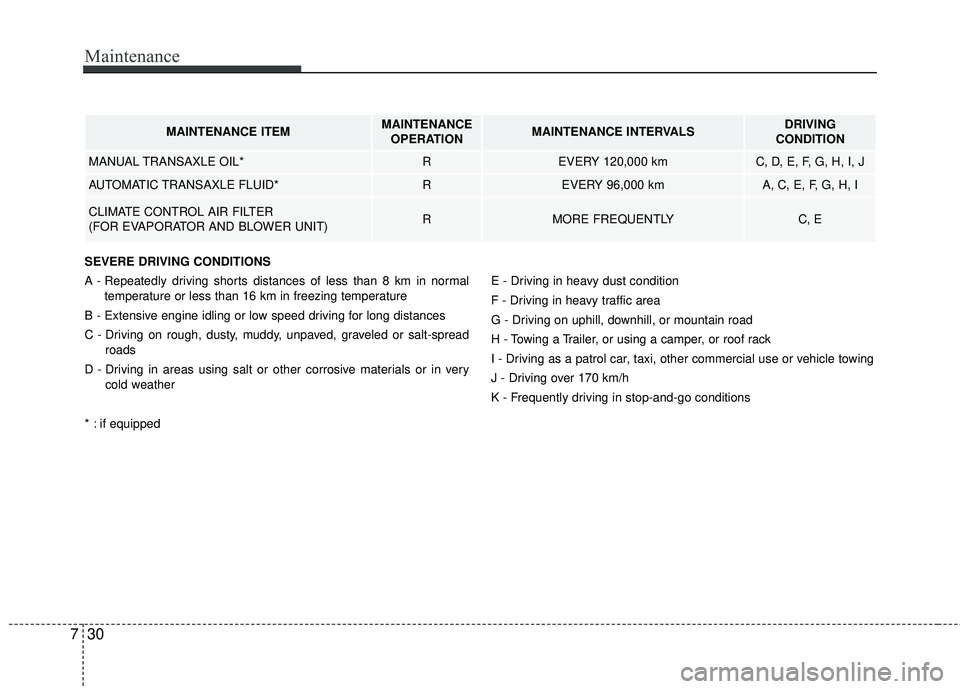
Maintenance
30
7
MAINTENANCE ITEMMAINTENANCE
OPERATIONMAINTENANCE INTERVALSDRIVING
CONDITION
MANUAL TRANSAXLE OIL*REVERY 120,000 kmC, D, E, F, G, H, I, J
AUTOMATIC TRANSAXLE FLUID*REVERY 96,000 kmA, C, E, F, G, H, I
CLIMATE CONTROL AIR FILTER
(FOR EVAPORATOR AND BLOWER UNIT)RMORE FREQUENTLYC, E
SEVERE DRIVING CONDITIONS
A - Repeatedly driving shorts distances of less than 8 km in normal
temperature or less than 16 km in freezing temperature
B - Extensive engine idling or low speed driving for long distances
C - Driving on rough, dusty, muddy, unpaved, graveled or salt-spread roads
D - Driving in areas using salt or other corrosive materials or in very cold weather E - Driving in heavy dust condition
F - Driving in heavy traffic area
G - Driving on uphill, downhill, or mountain road
H - Towing a Trailer, or using a camper, or roof rack
I - Driving as a patrol car, taxi, other commercial use or vehicle towing
J - Driving over 170 km/h
K - Frequently driving in stop-and-go conditions
* : if equipped
Page 448 of 449

Index
8I
THEFT-ALARM SYSTEM··················\
··················\
·······4-13Armed stage ··················\
··················\
··················\
···········4-13
Disarmed stage ··················\
··················\
··················\
······4-14
Theft-alarm stage ··················\
··················\
··················\
···4-14
Tire Pressure Monitoring System (TPMS) ··················\
····6-9 Changing a tire with TPMS··················\
··················\
·····6-12
Low tire pressure telltale ··················\
··················\
·········6-10
TPMS (Tire Pressure Monitoring System)malfunction indicator ··················\
··················\
············6-11
Tire specification and pressure label ··················\
···········8-10
Tires and Wheels ··················\
··················\
··················\
·····7-48 All season tires ··················\
··················\
··················\
·····7-58
Checking tire inflation pressure ··················\
················7-49
Low aspect ratio tire ··················\
··················\
················7-59
Radial-ply tires ··················\
··················\
··················\
······7-59
Recommended cold tire inflation pressures ················7-48
Snow tires ··················\
··················\
··················\
··············7-59
Summer tires··················\
··················\
··················\
··········7-58
Tire care ··················\
··················\
··················\
·················7-48\
Tire maintenance ··················\
··················\
··················\
···7-52
Tire replacement ··················\
··················\
··················\
····7-51
Tire rotation ··················\
··················\
··················\
···········7-50
Tire sidewall labeling ··················\
··················\
··············7-53
Tire traction ··················\
··················\
··················\
···········7-52
Wheel alignment and tire balance ··················\
·············7-51
Wheel replacement ··················\
··················\
··················\
7-52
Tires and wheels ··················\
··················\
··················\
········8-5 Towing ··················\
··················\
··················\
··················\
···6-28
Emergency towing ··················\
··················\
··················\
·6-30
Removable towing hook (Front) ··················\
···············6-29
Towing service··················\
··················\
··················\
·······6-28
Trunk (4 Door)··················\
··················\
··················\
·········4-20 Closing the trunk ··················\
··················\
··················\
···4-21
Emergency trunk safety release··················\
·················4-21\
Opening the trunk ··················\
··················\
··················\
··4-20
Vehicle break-in process ··················\
··················\
··············1-5
Vehicle certification label ··················\
··················\
············8-9
Vehicle data collection and event data recorders·············1-6
Vehicle identification number (VIN) ··················\
·············8-9
Vehicle load limit ··················\
··················\
··················\
·····5-53 Certification label ··················\
··················\
··················\
··5-56
Tire and loading information label ··················\
············5-53
Vehicle weight ··················\
··················\
··················\
·········5-58
Washer fluid ··················\
··················\
··················\
·············7-40 Checking the washer fluid level ··················\
················7-40
Weight/Volume ··················\
··················\
··················\
··········8-6
Windows ··················\
··················\
··················\
··················\
4-24 Manual windows ··················\
··················\
··················\
···4-27
Power windows··················\
··················\
··················\
······4-25
V
W